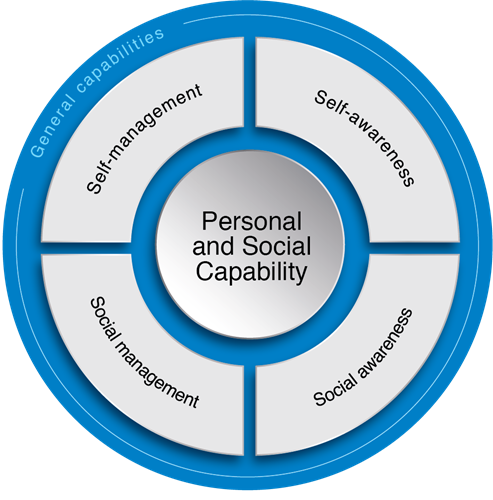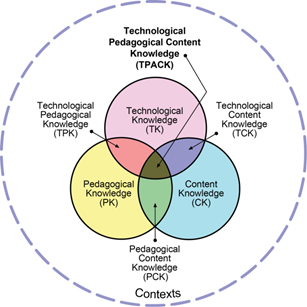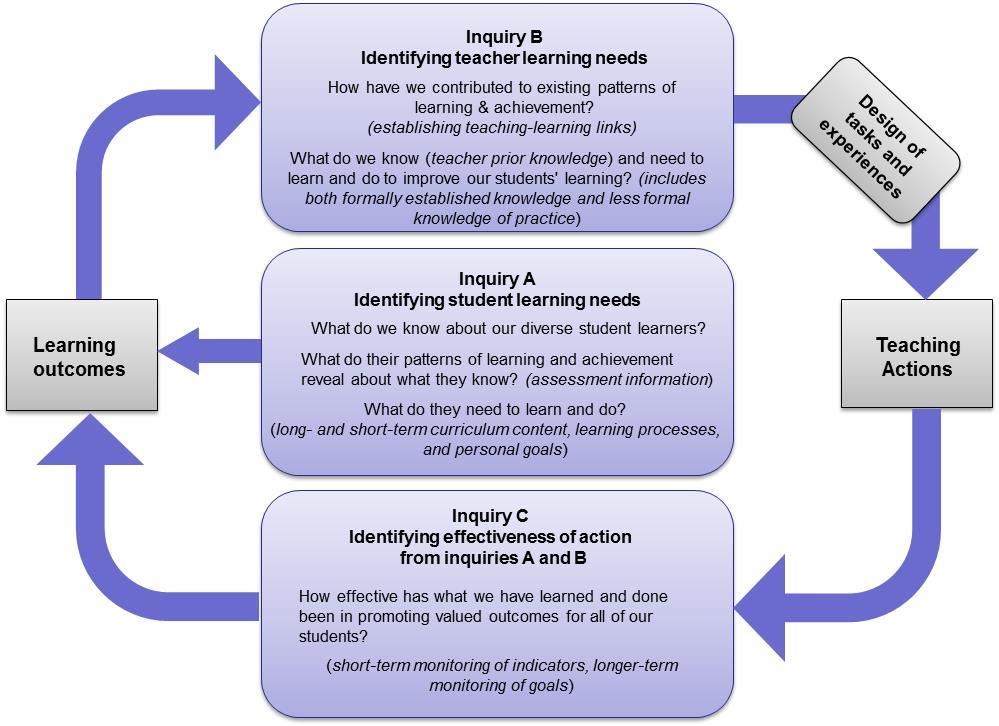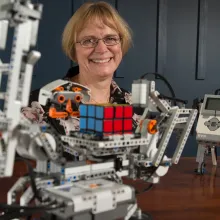
Social Robotics Clubs
Research summary
Robotics social clubs are inclusive school-based programs held during lunchtimes or after school.
Weekly team challenges using LEGO robotics resources create opportunities for all students, including students on the autism spectrum, to:
- learn and practise social skills
- make friends and socialise with peers over a common interest
- enhance their sense of engagement and belonging at school.
Robotics social clubs use students’ strengths and interests in technology in inclusive school-based settings. Particular characteristics of the clubs help to facilitate outcomes for students and generalisation of skills to the broader school context. While robotics social clubs are not a formal intervention, the design of the sessions and resources uses a number of elements known to be associated with greater student success.
Research aim
The robotics social club was piloted with a range of students in Years 7 and 8 at two secondary schools. This project was an initiative of Brisbane Catholic Education.
The aims of the pilot study were to:
- evaluate how the club provides opportunities for students to:
- learn the Australian Curriculum personal and social capabilities
- build peer relationships and academic engagement
- identify effective strategies that support generalisation of student engagement and relationships to the classroom setting
- build teachers’ confidence and competence in embedding the Australian Curriculum personal and social capabilities into teaching practice
- develop a resource kit and manual for schools interested in introducing a robotics social club.
Key elements
The pilot study involved robotics challenges that targeted elements of the Australian Curriculum.
Robotics social clubs develop students' capacity for social management by giving them opportunities to learn and practise how to:
- communicate effectively
- work collaboratively
- make decisions
- negotiate and resolve conflict
- develop teamwork skills.
Even if you are not interested in running a robotics social club, you can still use the nine robotics challenges provided on inclusionED. You can choose the challenges depending on which skills you want to develop.
On inclusionED, each Australian Curriculum social management skill is set up as an individual practice containing at least one robotics challenge.
Most challenges take 1–2 sessions of approximately 45 minutes each.
If you need to build a robot, then begin with the starter challenge. Otherwise, you can choose a practice depending on the skill you want to develop.
Communicate effectively: Robotics social clubs
- Starter challenge: Build your own robot
- Maze runner
Work collaboratively: Robotics social clubs
- Mexican wave
- Escape from the city
Make decisions: Robotics social clubs
- Silly walks
Negotiate, resolve conflict: Robotics social clubs
- Sumo building
- Sumo programming and testing
- Sumo battles
Improve teamwork skills: Robotics social clubs
In this challenge, the skill is chosen by the teacher and/or students based on student needs and identified areas for improvement.
- Space challenge
Each robotics challenge targets one of the five specific skills from the Australian Curriculum social management element:
- communicating effectively using words and body language to listen and explain
- working collaboratively as a team to achieve a goal
- negotiating and resolving conflict by listening, compromising, and resolving disagreement
- making decisions as a group, fairly
- developing leadership skills.
Social management is one of four interrelated elements in the Personal and Social Capability learning continuum:

Personal and Social Capability (ACARA, 2010)
© Australian Curriculum, Assessment and Reporting Authority (ACARA) 2010 to present, unless otherwise indicated. This material was downloaded from the Australian Curriculum website http://www.australiancurriculum.edu.au (accessed 28/01/2016) and was not modified. The material is licensed under CC BY 4.0. Version updates are tracked on the Curriculum version history page of the Australian Curriculum website.
ACARA does not endorse any product that uses the Australian Curriculum or make any representations as to the quality of such products. Any product that uses material published on this website should not be taken to be affiliated with ACARA or have the sponsorship or approval of ACARA. It is up to each person to make their own assessment of the product, taking into account matters including, but not limited to, the version number and the degree to which the materials align with the content descriptions (where relevant). Where there is a claim of alignment, it is important to check that the materials align with the content descriptions (endorsed by all education Ministers), not the elaborations (examples provided by ACARA).
Previous research identified effective pedagogical practices to support students on the autism spectrum to fully participate and access the curriculum. However, every student on the spectrum is unique and the strategies used to effectively support different students will vary.
This project found that effective strategies in the robotics social club included:
- explicit instruction and breaking tasks down
- structure and routine, and time management
- visual supports
- a learning focus using:
- prompting, coaching, reflection
- modelling, joint construction
- positive reinforcement and feedback
- practice and repetition
- the provision of a safe environment
- student-led group formation and different roles in the group
- a focus on the hidden learning
- allowances for differentiation and student ownership.
The key strategies below are effective for use in each robotics social club practice. Teachers can include the consistent use of these strategies in their own professional practice targets.
Robotics social clubs: Effective strategies
Additional information
Essential to inclusionED practices is the opportunity for teacher professional learning, with a focus on:
- identifying and meeting the needs of students on the autism spectrum
- developing pedagogical practices that support students to learn the Personal and Social Capabilities.
Teachers who participated in the robotics social club reported:
- increased knowledge of the Personal and Social Capabilities, and of robotics and technology
- increased knowledge of effective pedagogical practices, and individual students’ needs
- the ability to transfer these skills to settings outside the club, such as their classroom and the playground.
The professional learning processes that were important for teachers in the robotics social club included:
- completing reflections and planning
- sharing in staff meetings
- peer observation and mentoring
- teacher–student relationships.
TPACK framework
The Technology, Pedagogy, and Content Knowledge (TPACK) framework (Koehler & Mishra, 2009) identifies teachers’ professional learning needs that are critical for effective teaching with technology.
In the context of robotics social clubs, these needs are:
- Technological knowledge – understanding the LEGO robotics software, hardware, and programming. Relevant links can be found in ‘Technology knowledge for teachers’ below
- Pedagogical knowledge – understanding and applying teaching practices that are particularly relevant to teaching students on the autism spectrum (see ‘Developing pedagogical knowledge: Effective strategies’ above)
- Content knowledge – understanding the Australian Curriculum Personal and Social Capabilities.

The TPACK framework
You can use the TPACK framework to identify, reflect on, and track professional learning needs throughout the robotics social club program.
Which of these areas would you benefit from further information and support in to feel confident implementing the robotics social club program?
Each robotics social club practice includes videos to demonstrate the challenge. In addition, the information below may be helpful.
Robotics resources
Websites:
Books:
Blogs:
Videos:
Suggestions for networking in your state or organisation
Quick reference guide
Robotics social clubs: Quick reference guide
Check your fidelity
While there is flexibility around how robotics social clubs are implemented in schools, the following elements of the program are essential to its effectiveness in a school setting. These guidelines are drawn from a review of autism intervention research by Koegel, Matos-Freden, Lang, and Koegel (2012).
Analyse the social strengths and challenges of each student on the autism spectrum, then use this analysis to assess each student's current level in each area of the Personal and Social Capabilities continuum.
Use the student reflections and teacher assessments in each inclusionED robotics social club practice to continue to identify target areas.
Students on the spectrum often have few opportunities during the school day for positive social interaction in a motivating environment.
Appropriate teacher scaffolding during the robotics social club increases students’ opportunities for positive social interaction and communication with peers and teachers.
Use the detailed session plan in each inclusionED robotics social club practice to prepare, monitor and evaluate students’ teamwork skills – this is essential for self-management and generalisation of learnt skills.
Listen to students’ preferences in planning robotics challenges to maximise students’ engagement.
Run the robotics social club consistently to support students’ progress. If you follow the information in ‘Apply the practice’ in each inclusionED robotics social club practice, your implementation of the club will be consistent.
Inform parents of students on the spectrum about the skills that are targeted during the club, and encourage parents to follow up these skills at home. This helps students to:
- learn the skill
- maintain positive social behaviours over time.
The parent information sheet template below will assist with home–school communication. You could also invite parents to selected club sessions as an opportunity for students to develop a sense of mastery and expertise.
Robotics social clubs: Parent information template
Adapt this letter template and send it home to families of interested students.
Robotics social clubs were researched in mainstream school settings. Many of the essential elements of this program can only occur in an inclusive school or college setting.
Our evidence base
This project used a participatory action research methodology.
The project team applied a cycle of inquiry for developing teacher knowledge and effectiveness:

Figure 1. Inquiry cycles for developing teacher knowledge and effectiveness (Timperley & Alton-Lee, 2008).
- Inquiry A: Identifying student learning needs
- Inquiry B: Identifying teacher learning needs
- Inquiry C: Identifying the effectiveness of the action from Inquiries A and B in promoting positive outcomes for students
The participants in this project were:
- two schools. In each school, only some students attended the robotics social club, and some students took part in the study but didn’t attend the robotics social club
- students on the autism spectrum and same-aged peers not on the spectrum
- parents of students on the spectrum
- teachers.
Robotics social clubs: Participants
Find out more about the participants in this study.
Robotics social clubs: Measures
Find out more about the measures used in this study.
Social networks and friendships
All students who attended the club:
- established stronger friendships in more clearly defined groups rather than forming more connections with peers
- had increased nominations as ‘friends’ by peers over time.
Students on the spectrum:
- demonstrated an increased awareness of peer social networks, although same-aged peers experienced even greater increases in this awareness
- experienced greater benefits than their peers in their integration and acceptance into the social network of the club
- experienced greater benefits than their peers in the increase of the number of students they liked to hang out with, and the decrease in ‘rejections’ by peers.
Engagement
- The club appeared to have a positive effect on engagement
- The levels of engagement in the most vulnerable students seemed to increase.
Perceived benefits for students
Improved personal and social capabilities:
- teamwork skills, e.g. being cooperative, helpful, patient; sharing; communicating; listening; caring; compromising; making decisions; including others
- confidence, sense of success, and leadership skills
- resilience and skills in dealing with frustrations
- self-awareness of strengths and difficulties
- knowledge of others and development of friendships
Increased engagement:
- student–student relationships, e.g. got to know others, made new friends
- relevance to job and career interests
- enjoyment of robotics tasks
- generalisation to classroom and playground
Task/technology gains:
- creativity and problem-solving skills
Perceived benefits for teachers
- content knowledge, including increased knowledge in Personal and Social Capabilities, pedagogical knowledge, and robotics and programming
- generalisation of skills to the classroom and playground
- increased knowledge of individual students’ needs
- improved relationships with students
The challenges experienced and suggestions for improvement to the club influenced the resources available on inclusionED.
Social aspects and content
Facilitators of the club should:
- consider team configuration to minimise teamwork difficulties
- encourage consistent teams and attendance
- encourage student-led team formation
- reinforce that the robot belongs to a team
- encourage more students to join
- revise the learning intentions and success criteria.
Strategies and pedagogy
The club should involve:
- clear rules and expectations
- fair instructions and ownership of equipment
- development of positive attitudes
- structure and scaffolding
- scheduling and built-in flexibility
- enthusiastic teachers
- positive reinforcement and celebration of success.
Tasks and technology
Facilitators of the club should consider:
- availability of technical support
- capability of available technology and wifi
- the nature, variety, and creativity of challenges that allowed for more robot battles, races, and the use different robots
- teaching programming
- providing more time for the club
- providing support for teacher competence and confidence with robotics.
Generalisation of skills
The club should provide:
- information for parents
- information to families to help generate discussion at home – information could be communicated through a website, newsletter, email, or flyer
- families with the opportunity to attend sessions
- feedback from teachers
- links to classroom and broader applications.
Research snapshot
Robotics social clubs: Visual snapshot
Meet the researchers

Kaitlin Hinchliffe

Mr. Jay Hobbs

Dr Beth Saggers

Dr Christina Chalmers
All researcher details including names, honorifics (for example ‘Dr’), and organisational affiliations are correct at the time of the project.
Publications from this project
Articles informing this project
Cairns, R. B., & Cairns, B. D. (1994). Lifelines and risks: Pathways of youth in our time. New York, NY: Harvester Wheatsheaf.
Chiang, H.-M. (2009). Naturalistic observations of elicited expressive communication of children with autism: An analysis of teacher instructions. Autism, 13(2), 165–178. https://doi.org/10.1177/1362361308098513
Constantino, J. N., & Gruber, C. P. (2012). Social Responsiveness Scale (2nd edn). Torrance, CA: Western Psychological Services.
Koegel, K., Carter, M., & Koegel, L. (2003). Teaching Children with Autism Self-Initiations as a Pivotal Response. Topics in Language Disorders, 23(2), 134–145. https://doi.org/10.1097/00011363-200304000-00006
Koegel, L. K., Koegel, R. L., & Dunlap, G. (Eds.). (1996). Positive behavioral support: Including people with difficult behavior in the community. Paul H Brookes Publishing.
Koegel, L., Matos-Freden, R., Lang, R., & Koegel, R. (2012). Interventions for children with autism spectrum disorders in inclusive school settings. Cognitive and Behavioral practice, 19(3), 401-412.
Koegel, L. K., Vernon, T. W., Koegel, R. L., Koegel, B. L., & Paullin, A. W. (2012). Improving social engagement and initiations between children with autism spectrum disorder and their peers in inclusive settings. Journal of Positive Behavior Interventions, 14(4), 220–227.
Koegel, R. L., & Koegel, L. K. (1990). Extended reductions in stereotypic behavior of students with autism through a self‐management treatment package. Journal of Applied Behavior Analysis, 23(1), 119–127.
Koegel, R. L., & Koegel, L. K. (2006). Pivotal response treatments for autism: Communication, social, & academic development. Paul H Brookes Publishing.
Koehler, M. J., Mishra, P., & Cain, W. (2013). What is Technological Pedagogical Content Knowledge (TPACK)? Journal of Education, 193(3), 13–19. https://doi.org/10.1177/002205741319300303
Martin, A. (2007). Examining a multidimensional model of student motivation and engagement using a construct validation approach. British Journal of Educational Psychology, 77, 413–440.
Ormrod, J. E. (2006). Educational psychology: Developing learners. Upper Saddle River, NJ: Pearson Merrill Prentice Hall.
Timperley, H., & Alton-Lee, A. (2008). Reframing teacher professional learning: An alternative policy approach to strengthening valued outcomes for diverse
learners. Review of Research in Education, 32(1), 328–369.
Practices

Negotiate, resolve conflicts: Robotics social clubs
TEACHING PRACTICE
For student years
Helps students to
- suggest solutions
- compromise

Work collaboratively: Robotics social clubs
TEACHING PRACTICE
For student years
Helps students to
- collaborate
- encourage others
- work in a team

Improve teamwork skills: Robotics social clubs
TEACHING PRACTICE
For student years
Helps students to
- collaborate
- express ideas
- compromise

Communicate effectively: Robotics social clubs
TEACHING PRACTICE
For student years
Helps students to
- collaborate
- express ideas

Make decisions: Robotics social clubs
TEACHING PRACTICE
For student years
Helps students to
- problem-solve
- collaborate
- take turns